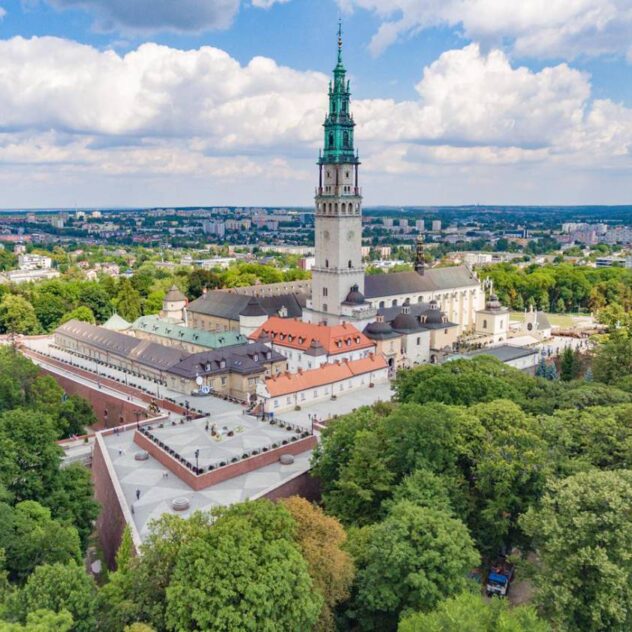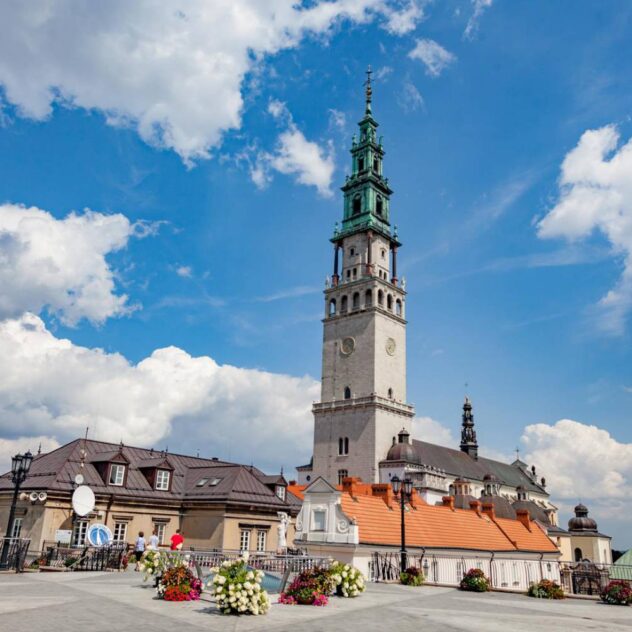Jasna Góra - Sanctuary of the Blessed Virgin Mary
Information about the pilgrimage site
The Sanctuary of the Blessed Virgin Mary on Jasna Góra is the most visited Polish Marian shrine and one of the most important in the world. It is located in Częstochowa, in the southern part of Poland. Pilgrims go to the monastery complex of the Pauline Fathers to honour the miraculous image of Mary and Child (the Black Madonna), which was brought to Częstochowa in the 15th century. The present buildings of the monastery complex date mainly from the 17th century, were designed by the Italian architect Giovanni Battista Trevano and represent the Baroque style. The interior of the sanctuary impresses with paintings, sculptures and gilded details.
The origins of the sanctuary date back to the second half of the 14th century, when Prince Władysław Opolczyk brought the Pauline monks from Hungary to Częstochowa in 1382, who “brought” with them the name of the mother monastery – St Lawrence on Jasna Góra in Buda. Shortly afterwards, the prince donated an icon of the Mother of God and Child found in Russia to the monastery’s church, built on a limestone hill. According to legend, the image was painted by St Luke himself, on a board from the house of the Holy Family of Nazareth, while researchers say it dates from the second half of the first millennium and is the work of a Byzantine painter. Jasna Góra became a popular pilgrimage site as early as the 15th century, but the real flowering of Marian devotion occurred in the 17th century. Popes, kings, aristocrats, statesmen and representatives of all social classes prayed in Częstochowa.
Jasna Góra, witnessing many important historical events, such as the defence against the Swedes in the 17th century or the Jasna Góra Vows of the Polish Nation in 1956, is a symbol of national unity for Poles.
Today, Jasna Góra is visited by up to 3.5 million pilgrims a year. The buildings of the monastery complex that have survived to this day began to be built as early as the 15th century. Among others, the presbytery of the Jasna Góra basilica is Gothic. In the 17th century, the monastery was fortified according to the most modern models of the time and the whole complex was rebuilt in the Baroque style. Most of the basilica and the Chapel of the Miraculous Picture, the St Anthony Chapel, the tower, the refectory and the Knights’ Hall date from this period. The 18th century decorations include the library, which houses around 15,000 incunabula, manuscripts and old prints. An important building created in the 20th century is the Chapel of the Nation’s Remembrance, which serves as a mausoleum. Valuable supplication and thanksgiving votive offerings are collected in the Jasna Gora Treasury, which is located above the sacristy. The Museum of the 600th Anniversary of Jasna Góra, opened in 1982, is also worth a visit. The figures of Father Augustyn Kordecki, the Primate of the Millennium – Cardinal Stefan Wyszyński and Pope John Paul II are honoured at Jasna Góra with magnificent monuments.
The shrine also acts as an important cultural and educational centre by organising thematic conferences, exhibitions and other religious and cultural events.
The faithful coming to Jasna Góra, who want to experience this time to the fullest, can stay for the Jasna Gora Appeal, a solemn service held every day at 9 p.m. since 1953.
Tourist attractions in the vicinity
The Museum of the 600th Anniversary of Jasna Góra – located at the monastery in Częstochowa, offers a unique insight into the rich history of the site. Housed in a former print shop that operated from the 17th century until its closure by the Russian invaders in 1864, the museum was opened in 1982 to celebrate the 600th anniversary of the monastery’s foundation by Prince Władysław Opolczyk. The solemn celebrations of the jubilee, coinciding with the pontificate of Pope John Paul II and the Solidarity period, gave the event a special character.
The idea of founding a museum as the main commemoration of the jubilee came from the then General of the Pauline Order, Fr Józef Płatek, and the Prior of Częstochowa, Fr Konstantin Kunz. Fr Jan Golonka and Marek Rostworowski were invited to organise the exhibition, which resulted in the creation of a place presenting the phenomenon of the presence of the Virgin Mary and the Pauline monks at Jasna Góra for over 600 years.
The museum presents votive offerings from various pilgrim groups, including prominent artists and writers, as well as votive offerings from John Paul II, including a cross made from fragments of the World Trade Center and gifts from President Lech Kaczyński. The collection includes 17th-century paintings by Pauline hermits, portraits of the order’s Polish provincials, and exhibits reflecting the Sarmatian culture of Poland in the 17th and 18th centuries. The exhibition also shows the cultural activities of the Pauline Order, presenting a collection of musical instruments from the 17th and 18th centuries and books published in the Jasna Góra printing house. The Museum of the 600th Anniversary of Jasna Góra is an important part of Poland’s cultural heritage, continuing the tradition of the Jasna Gora treasury. (http://jci.jasnagora.pl/pl/p13,Muzeum-600-lecia)
The Archcathedral of the Holy Family – which is one of the city’s most important monuments – is not only a place of religious worship, but also an exceptional example of sacred architecture. This impressive building is a witness to the history and culture of Częstochowa, playing an important role in the life of the city and the region.
The archcathedral has its roots in the late 19th century. It was built in response to the growing religious needs of the growing city. Its construction, which began in 1901, went on for many years, with interruptions caused, among other things, by the First World War. The final consecration took place in 1927. The archcathedral is distinguished by its neo-Gothic style, which is evident in its tall, soaring towers, richly decorated portals and vaults. The interior of the church is equally impressive, with richly decorated altars, stained glass windows and paintings that together create a harmonious and solemn space.
The Archcathedral is open to the public, offering the opportunity to admire its architectural and artistic treasures. A visit to the Archcathedral offers a unique opportunity to immerse yourself in history and spirituality, while bearing witness to the rich tradition and culture of Częstochowa.
Old Market Square in Częstochowa – underwent a significant metamorphosis in 2021, becoming a unique place combining history with modernity. The redevelopment of this historic space included the modernisation of the Market Square’s slabs and the renewal of adjacent streets. A glazed pavilion, serving as an archaeological and historical museum and enriched with a service and catering area, was built where the Town Hall once stood. This new facility, managed by the Częstochowa Museum, encourages exploration of the city’s past with exhibits from the days of old Częstochowa.
The revitalisation of the Old Market Square has also introduced elements of contemporary design, such as a modern, strikingly lit fountain and thoughtfully designed spaces for rest and recreation. The stairs by the pavilion can serve as an amphitheatre for events organised here. However, the most distinctive feature of the new Old Market is the original sculptures by Jerzy Kędziora, creating a ‘theatre’ of balancing figures that give the place a unique character.
Thanks to these transformations, the Old Market has become a key point on the map of Częstochowa, attracting residents and tourists. It is an example of the successful integration of cultural heritage with modern urban planning, thanks to which the Old Market has regained its place in the hearts of Częstochowa’s citizens and become one of the city’s showpieces.
St. Sigismund’s Church in Częstochowa – probably built in the first half of the 15th century, it is one of the oldest monuments in the city, once serving as the only parish church until the end of the 19th century. Originally a Gothic parish church, it gained its present Baroque appearance thanks to an 18th-century reconstruction. It is a three-nave church, distinguished by two towers at the front and an adjacent 17th-century monastery building, now used as a vicarage.
The history of the church dates back to the beginnings of Częstochowa in the 14th century, and the local parish may be even older, as evidenced by records from the 1920s of that century. With the arrival of the Pauline monks and the location of the image of Our Lady at Jasna Góra, the parish moved to St Sigismund’s Church, which for centuries had been the main church for the townspeople. Over the years, the church was destroyed, rebuilt and rebuilt, evolving from an originally Gothic edifice into a Baroque basilica with Gothic fragments.
The contemporary church on Daszyńskiego Square impresses with Baroque architecture with Gothic remains, especially in the presbytery. Two towers on a square plan, covered with Baroque cupolas, dominate the façade, which is topped with a triangular gable. A narrower presbytery adjoins the wide nave, and the entire interior retains a Baroque character with valuable Gothic elements. The church is also decorated with a plaque commemorating the visit of Pope John Paul II in 1979, and a monument to this Polish pope was erected in front of the church, further emphasising its historical and spiritual significance.
Częstochowa Town Hall – built between 1826 and 1834 at St James’s Square, now known as Biegański Square, is an important cultural landmark of the city. Its construction was part of the process of uniting Old and New Częstochowa. The architecture of the town hall represents the late classicist style, designed on a square plan by Franciszek Reinstein, a builder of the Kalisz province. For more than a century the building served as the seat of the municipal authorities.
Since 1967, the building has been handed over to the Częstochowa Museum, becoming the venue for exhibitions on the history of the city, as well as exhibitions of paintings and photographs. In addition to its museum functions, the Town Hall serves as a cultural centre, hosting concerts, book promotions and meetings with cultural people, including writers and historians. The clock tower of the Town Hall is worth a visit, offering a panoramic view of Częstochowa, and the spaces of the outbuilding are used by the museum administration.
Najświętszej Maryi Panny Avenue (Aleja NMP) in Częstochowa – is not only the most recognisable, but also the most fascinating street in the city in terms of urban planning. Designed in the first half of the 19th century by Jan Bernhard, this 1.5 km-long thoroughfare connects the Old Town with Popieluszko Street and the green spaces near Jasna Góra. Its architecture and aesthetics, with dominant neo-classical townhouses, are reminiscent of the beauty of French boulevards, and the towering townhouses are reminiscent of those in Vienna and Berlin.
The Avenue of the Blessed Virgin Mary plays a central role in the life of Częstochowa, being the place through which thousands of pilgrims move on their way to Jasna Góra. It is also the vibrant heart of the city, where commerce, culture and city events are concentrated. The width of the street is 44 metres, making it spacious and convenient for residents and visitors alike.
The history of the Avenue of the Blessed Virgin Mary dates back to the beginning of the 19th century, when it connected Częstochowa proper with New Częstochowa, formally united into one urban organism in 1826. Today, the avenue is a key link between the Old Town and the Podjasnogórska district, constituting not only an important urban element but also a symbol of the city of Częstochowa.
The Museum of Match Production in Częstochowa – is the only active museum of matches in Europe, being at the same time the first, and thus the oldest, match factory in Poland and one of the first in Europe. The exhibits made available to the public are located in two exhibition halls and in a former production plant from the 1930s, which uses a production line from that period. The main part of the museum is the factory where, among other things, matches from the popular Black Cat series were produced until 2010. In the museum, visitors can see the historic machinery and trace the production cycle from debarking wood through to making sticks and packaging matches into boxes, as well as the oldest relic of Polish cinematography – depicting the factory fire of 1913. It is here that the past and the present lie closely side by side and even intermingle. The Częstochowa match factory is a “manufacturing museum”, and its decades-old technology and techniques are a unique attraction for school trips and tourists from all over Europe. For more information, visit (https://www.zabytkitechniki.pl/culturalheritage/1704/muzeum-produkcji-zapalek).
Trail of the Eagles’ Nests – is one of the most beautiful trails in Poland. It is 163.9 km long and connects Krakow and Częstochowa. While traversing it, one can admire numerous ruins and castles, which were built on hilltops, among hardly accessible limestone rocks – hence its name “Eagles’ Nests”. On the trail, one can also admire historic religious buildings and numerous natural wonders. The first proposal for the creation of the trail was made in 1927 by Stanisław Leszczycki in the pages of the “Ziemia” magazine. (https://orlegniazda.pl/).
For more information visit https://www.niesamowitapolska.eu/wojewodztwa/slaskie/miasta/czestochowa-atrakcje-turystyczne#jasna-gora, the website of the Częstochowa Tourist Organisation: http://www.czot.pl/ or the website of the Krakow-Częstochowa Jurassic Highlands: https://jura.slaskie.travel/.
Accommodation
– Dom Pielgrzyma na Jasnej Góra – is located in the very heart of Jasna Góra and hosts thousands of pilgrims coming before the face of the Black Madonna every year. The distance between the Pilgrim’s House and the Sanctuary is only 250 metres. Web https://dp.jasnagora.pl/ .
– Other accommodation: https://jasnagora.pl/pl/dla-pielgrzymow/noclegi/hale-noclegowe/
Other private accommodation or hotels.
Availability
By car
The pilgrimage site can be reached from several directions:
- A1 motorway and exit at one of the junctions, Częstochowa Południe Junction to the south, Jasna Góra Junction to the west, Częstochowa Północ “Rząsawa” Junction to the north.
- DK43 road, Wieluń – Częstochowa
- By road DK 46, Kłodzko – Szczekociny
- Route 91 (old DK1), Gdańsk – Podwarpie
There is a large car park next to the Sanctuary.
By public transport
Pilgrims arriving to Częstochowa by public transport (PKP, PKS, etc.), in order to get to Jasna Góra most conveniently, should take public transport to the area of Jasna Góra and then walk. From the area of the Main Railway and Bus Stations, city bus No. 31 (in the direction of “municipal cemetery”) runs to the bus stop “Jasna Góra”, located in Ks. Kordeckiego Street. Detailed timetable for bus no. 31 can be found on the MPK Częstochowa website – https://www.mpk.czest.pl/ . A taxi from the railway or bus station to Jasna Góra costs about PLN 16 (below contact details of one of the taxi corporations: TELE-TAXI tel. 34 361-61-61 https://www.tele-taxi.czest.pl/).
On foot
The route from the railway station (Częstochowa Główna) to Jasna Góra is approx. 3 km, and the crossing takes approx. 1 hour. The route from the railway station (Częstochowa Stradom) to Jasna Góra is approx. 2 km, and the crossing takes approx. 40 min. The route from the bus station to Jasna Góra is approx. 3.5 km, and the crossing takes approx. 1 hour 15 min.
On a bicycle
There is good cycling access to the pilgrimage site. Current cycle routes are marked on various tourist maps.








